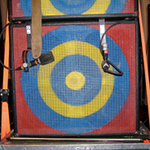Xavier Deshoulières
Behind the Green Door
Virgil de Voldère Gallery
526 West 26th Street, Room 416, New York, NY
May 8–June 21, 2008
Virgil de Voldère Gallery is proud to present its third solo exhibition with Xavier Deshoulières, a French artist based in Paris. Entitled Behind the Green Door, the exhibition is comprised of five paintings that feature his singular painting technique and an emphasis on elusive, mysterious narrative. Although the artist’s recent subject matter is diverse—a military jet, a jungle, dilapidated houses, Atlantic City hotels—a common iconographic element found in most works is the barren tree, its branches and limbs as depopulated with leaves as the built structures Deshoulières renders are with people. Nature and architecture, thus, are mysterious frameworks or skeletons on which the viewer can build his or her narratives.
Deshoulières begins his work by first attending to the back of the canvases—he sketches details of figures and forms and then scatters powdered pigment and rubs oil into the fabric, creating fields of color similar to the stained canvases of Helen Frankenthaler and Morris Louis over the details. After flipping the canvas, he adds more figurative elements to the front, on top of what bleeds through from the back. This doubling of imagery—on obverse and reverse sides—is not unlike watching a film or slide show projected on both sides of a screen.
Yet far from a formalist, Deshoulières gives an attention to narrative that reflects his training in Düsseldorf, Germany, under Jörg Immendorff, Gerhard Richter, and Sigmar Polke. Like those artists, Deshoulières unveils dreamlike or hallucinatory situations in his work, exploring dimensions of the real and the imaginary. The superimposition of imagery and the shifting of perspective illustrate the fading nature of memory and the power of the imagination.
In his solo debut in New York two years ago, Deshoulières showed canvases of seemingly commonplace scenes from Beirut, using his own photographs as source material, that actually depict significant buildings and scenarios in recent Lebanese history. For instance, Saint Georges partially shows a luxury hotel of the same name—a well-known vacation destination in Lebanon before its civil war began in 1975—where the former Prime Minister Rafik Hariri was assassinated in 2005.
In the works on view now, Deshoulières’s imagery, however, has become more oblique: references are obscured and camouflaged while remaining visual engaging. The dense painting Jungle recalls frottage (rubbing) and grattage (scraping) techniques invented and pioneered by Max Ernst, while also evoking that artist’s perplexing tableaux. In another work, a military airplane traverses the canvas in front of (or is it behind?) a ghostly, barren tree that seeps from the back of the canvas. A vertical and horizontal opposition is established but never truly clarified.
In two works, entitled Yellow Trees and Taj Mahal, Deshoulières sets dilapidated houses in the middle ground against a backdrop of modern hotels in Atlantic City, New Jersey. The utility poles and insulated telephone wires seem to stand in for the bare branches and twigs—shaken of leaves for the winter—that partially obscure another beat-up two-story home in a third painting, Herbes Seches, which also places a couch in the front yard next to an overflowing garbage bin. In all, two fields or bands of color stained from the reverse side of the canvas separate the land from the sky.
Images





